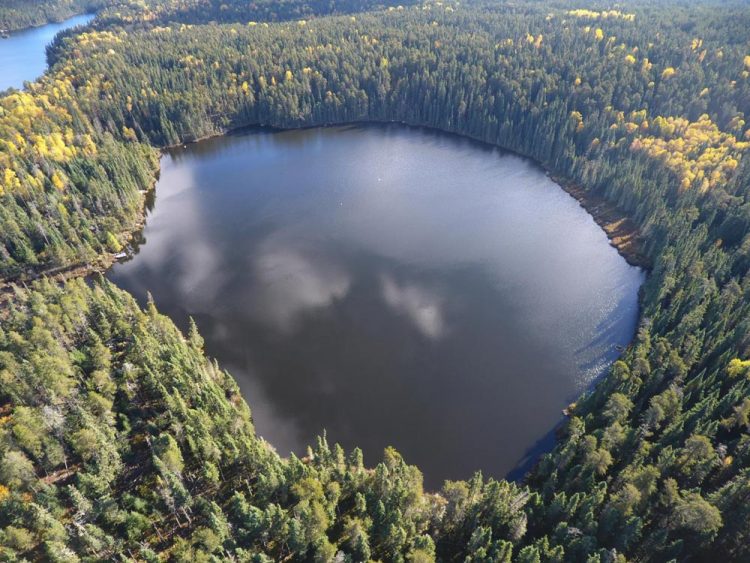Reducing how much nitrogen enters a lake has little impact on algal blooms

Drone shot of Lake 227 at IISD Experimental Lakes Area where the experiment on eutrophication has been taking place since 1969. Credit: IISD Experimental Lakes Area
This is according to a recently published article in Springer's Ecosystems journal, Biological Nitrogen Fixation Prevents the Response of a Eutrophic Lake to Reduced Loading of Nitrogen: Evidence from a 46-Year Whole-Lake Experiment. The paper presents the results of a 46-year whole-ecosystem experiment at IISD Experimental Lakes Area in northwestern Ontario, Canada.
Since 1969, researchers have been artificially manipulating a lake by adding varying amounts of carbon, nitrogen, and phosphorus to investigate the nutrients responsible for algal blooms. Throughout the experiment, researchers have been continually adding phosphorus.
However, forty years ago, researchers began reducing the amount of nitrogen they were adding to the lake, and from 1990-2013, they cut artificial nitrogen loading to zero. Despite these dramatic cuts in nitrogen loading algal blooms continued to cover the lake.
“We have been researching the role of artificial nitrogen in algal blooms for almost 50 years now, and these latest results clearly demonstrate that ceasing nitrogen loading into lakes has little effect on the size or duration of algal blooms,” said Dr. Scott Higgins, Research Scientist at IISD Experimental Lakes Area and lead author on the paper.
“A number of algal species can make up for nitrogen deficits by fixing atmospheric nitrogen that is dissolved in the water. What is clear here is that phosphorus is the key driver of algal blooms in lake environments,” added Higgins.
These results have clear implications for policy geared towards reducing algal blooms–especially for jurisdictions dealing with limited budgets.
“When governments are tackling algal blooms while working with limited resources, these results demonstrate that their efforts should be firmly focused on reducing phosphorus loading in lakes,” said Dr. Michael Paterson, Senior Research Scientist at IISD Experimental Lakes Area, and secondary author on the paper.
Algal blooms are unsightly growths on water bodies that can produce toxins harmful to humans and animals, affect drinking water supplies, cause low oxygen 'dead zones' that result in fish kills, and a number of other negative consequences. Many freshwater lakes around the globe, including Lake Erie, Lake Winnipeg and Lake Taihu, have suffered from algal blooms for decades.
Research at IISD Experimental Lakes Area, the world's freshwater laboratory, identified phosphorus as the leading cause of algal blooms in lakes back in the 1970s, in a groundbreaking experiment on a whole lake ecosystem.
###
For more information, and to arrange an interview with the scientists, contact:
Sumeep Bath,
Media and Communications Officer,
IISD Experimental Lakes Area,
sbath@iisd.ca or 1-204-958-7700 ext. 740
Media Contact
All latest news from the category: Earth Sciences
Earth Sciences (also referred to as Geosciences), which deals with basic issues surrounding our planet, plays a vital role in the area of energy and raw materials supply.
Earth Sciences comprises subjects such as geology, geography, geological informatics, paleontology, mineralogy, petrography, crystallography, geophysics, geodesy, glaciology, cartography, photogrammetry, meteorology and seismology, early-warning systems, earthquake research and polar research.
Newest articles

Silicon Carbide Innovation Alliance to drive industrial-scale semiconductor work
Known for its ability to withstand extreme environments and high voltages, silicon carbide (SiC) is a semiconducting material made up of silicon and carbon atoms arranged into crystals that is…

New SPECT/CT technique shows impressive biomarker identification
…offers increased access for prostate cancer patients. A novel SPECT/CT acquisition method can accurately detect radiopharmaceutical biodistribution in a convenient manner for prostate cancer patients, opening the door for more…

How 3D printers can give robots a soft touch
Soft skin coverings and touch sensors have emerged as a promising feature for robots that are both safer and more intuitive for human interaction, but they are expensive and difficult…




















